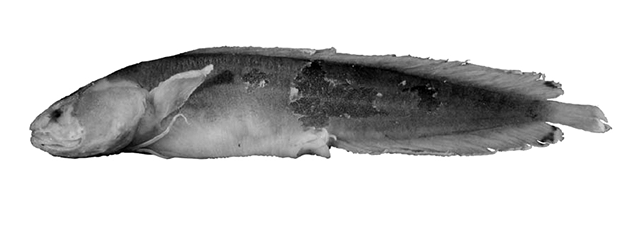| Dinematichthyidae (Viviparous brotula) |
| 4 cm SL (male/unsexed); 4.8 cm SL (female) |
|
reef-associated; marine; depth range 0 - 4 m |
| Western Pacific: SE Australia, south of the Great Barrier Reef, chiefly along the shores of New South Wales. |
|
Dorsal soft rays (total): 67-77; Anal soft rays: 46-53; Vertebrae: 40-43. The species is characterized by the following: vertebrae 11-14 + 27-31 = 40-43, dorsal fin rays 67-77, anal fin rays 46-53; no scales on the head and body; posterior nostril large, about half size of eye; lower preopercular pore large, about size of posterior nostril or larger; weak spine on maxilla positioned behind rear tip of eye; single pair of pseudoclaspers curved, expanded and paddle-like, longer than penis, without fleshy appendices; otolith with pointed posterior tip and concavity above and massive postdorsal angle, otolith length to height ratio 1.9-2.0, sulcus with divided colliculi (Ref. 57886). |
| Occurs along rocky shores at shallow depths. A female specimen (AMS 15330-037, 42 mm SL), contained 3 embryos, 11-16 mm SL. The species is pale except for some weak pigmentation on top of head (Ref. 57886). |
|
Least Concern (LC); Date assessed: 16 August 2019 Ref. (130435)
|
| harmless |
Source and more info: www.fishbase.org. For personal, classroom, and other internal use only. Not for publication.

